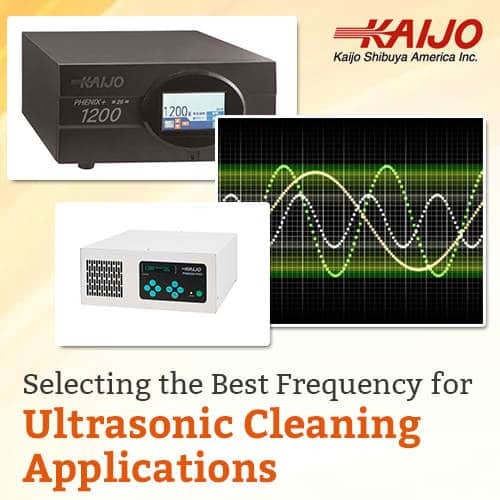Selecting the Best Frequency for Ultrasonic Cleaning Applications
January 21, 2020
 Effective cleaning of parts with industrial ultrasonic cleaners depends on matching the system frequency to the parts to be cleaned and to the material to be removed. Low frequencies deliver high-energy cleaning for robust parts with hard surfaces and for heavy contamination. Cleaning with mid-range frequencies is for more fragile components but the systems can still remove substantial surface dirt. For the most delicate components, using the highest frequencies ensures that the cleaning action doesn’t damage the parts. An experienced industrial ultrasonic equipment manufacturer can help with the selection of the best frequency and ensure that ultrasonic cleaning performance is at optimal levels.
Effective cleaning of parts with industrial ultrasonic cleaners depends on matching the system frequency to the parts to be cleaned and to the material to be removed. Low frequencies deliver high-energy cleaning for robust parts with hard surfaces and for heavy contamination. Cleaning with mid-range frequencies is for more fragile components but the systems can still remove substantial surface dirt. For the most delicate components, using the highest frequencies ensures that the cleaning action doesn’t damage the parts. An experienced industrial ultrasonic equipment manufacturer can help with the selection of the best frequency and ensure that ultrasonic cleaning performance is at optimal levels.
How the Ultrasonic Frequency Impacts Cleaning Results
Ultrasonic cleaning depends on the generation of microscopic bubbles in a cleaning solution. These cavitation bubbles are produced by transducers converting electric high-frequency signals into sound waves that travel through the cleaning bath. Low-frequency waves produce comparatively large, energetic bubbles that deliver a powerful scrubbing action. Higher frequencies produce smaller bubbles for gentler cleaning. Matching the ultrasonic frequency to the cleaning application delivers enough cleaning power to remove the contaminants on the surfaces of the parts to be cleaned while leaving the underlying material undamaged.
If the chosen frequency is too high, the gentle cleaning action of the smaller cavitation bubbles will take longer to remove surface dirt from the parts to be cleaned. If the ultrasonic frequency is too low, the strong scrubbing of the large bubbles can damage the parts. Large, energetic cavitation bubbles can cause pitting in part surfaces and can damage micro-structures such as those on semiconductor components. The surfaces of coated parts such as lenses can be eaten away and protective films deposited on metal parts may be removed. Selecting the right frequency results in quick and complete cleaning of parts that have undamaged surfaces and intact structures.
How to Choose the Best Frequency for Optimal Cleaning Performance
Low frequencies for ultrasonic cleaning are usually below 40 kHz. Typical cleaning frequencies are 26 kHz and 38 kHz. These frequencies are suitable for metal, glass or porcelain parts with heavy contamination and hard surfaces. Parts to be cleaned include engine parts contaminated with oil and grease, uncoated glass components, jewelry coated with production residues and some medical equipment.
Mid-range frequencies range from 40 kHz to 200 kHz with typical frequencies including 78 kHz, 100 kHz, 130 kHz and 160 kHz. Parts with softer surfaces, resistant coatings and solid micro-structures are suitable for cleaning at these frequencies. Such parts include hard disk drives, solar cells, LCDs and parts made of ceramics or aluminum. Ultrasonic systems operating at mid-range frequencies deliver rapid and complete cleaning for a wide range of parts that are not easily damaged.
The most delicate parts have to be cleaned at frequencies from 200 kHz up to the MHz range. Typical frequencies are 200 kHz, 430 kHz, 950 kHz and 1.6 MHz. The highest frequencies deliver very gentle cleaning with cavitation bubbles that have little energy. Parts to be cleaned at these frequencies have soft surfaces, delicate coatings or they include fragile micro-structures that cleaning can damage. The small bubbles clean light contamination completely and the frequencies are suitable for parts such as semiconductor components, silicon wafers, LEDs, and delicate medical instruments.
Kaijo Can Help Select the Best Frequency
With extensive experience in the field of ultrasonic cleaning technology, Kaijo can help customers choose the industrial ultrasonic cleaners best suited to their applications. In addition to advice on the best frequency, the company can help with other system characteristics such as power, transducer type and size of bath. With the in house expertise gained from manufacturing its own ultrasonic cleaners, Kaijo can make sure its systems deliver the cleaning performance required for the cleaning application.





